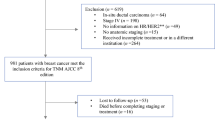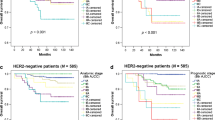Abstract
The objective of this study is to investigate staging system of the stage IIIB and stage IIIC Breast cancer and determine the criteria for an update of the classification system. Since AJCC 6th edition, it is pointed out that stage IIIB showed a worse outcome compared with stage IIIC. Using information from two databases, including the nationwide Korean Breast Cancer Registry (KBCR), three cohorts composed of patients from the asan medical center from 1989 to 2002 (cohort I), from 2003 to 2008 (cohort II), and KBCR from 2003 to 2005 (cohort III) were assembled. New classifications were suggested that rearranged stage IIIB as T1-3N3 disease and stage IIIC as T4 any N disease. From the joint analysis of 9640, invasive breast cancer patients from cohorts I and II showed the stage IIIB group showed a significantly worse DFS (HR 10.4, 95 % CI 6.9–15.7) compared with the stage IIIC group (HR 7.2, 95 % CI 5.9–8.7). T4d breast cancer showed worse DFS than T4 abc breast cancer but not significant (p = 0.505). The survival of patients with T1N3 and T2N3 tumors was higher than the other groups, and patients with T4N3 tumors showed the worst survival outcomes in terms of DFS, CSS. Using new suggested classification, in cohort III, the stage IIIB HR for CSS was changed from 15.4 (95 % CI 10.6–22.1) in the AJCC 6th edition to 12.6 (95 % CI 10.1–15.6) in the proposed new staging system. The stage IIIC HR for CSS was changed from 13.3 (95 % CI 10.7–16.4) in the AJCC 6th edition to 18.9 (95 % CI 14.0–25.6) in the proposed new staging using stage I as a reference. Reclassification of T4 any N disease as stage IIIC and T1-3N3 disease as stage IIIB is appropriate.




Similar content being viewed by others
References
Diab SG, Hilsenbeck SG, de Moor C, Clark GM, Osborne CK, Ravdin PM, Elledge RM (1998) Radiation therapy and survival in breast cancer patients with 10 or more positive axillary lymph nodes treated with mastectomy. J Clin Oncol 16:1655–1660
Nemoto T, Vana J, Bedwani RN, Baker HW, McGregor FH, Murphy GP (1980) Management and survival of female breast cancer: results of a national survey by the American College of Surgeons. Cancer 45:2917–2924
Paik S, Bryant J, Park C, Fisher B, Tan-Chiu E, Hyams D, Fisher ER, Lippman ME, Wickerham DL, Wolmark N (1998) erbB-2 and response to doxorubicin in patients with axillary lymph node-positive, hormone receptor-negative breast cancer. J Natl Cancer Inst 90:1361–1370
Duraker N, Caynak ZC (2005) Prognostic value of the 2002 TNM classification for breast carcinoma with regard to the number of metastatic axillary lymph nodes. Cancer 104:700–707
Ahn SH, Son BH, Kim SW, Kim SI, Jeong J, Ko S-S, Han W (2007) Poor outcome of hormone receptor-positive breast cancer at very young age is due to tamoxifen resistance: nationwide survival data in Korea—a report from the Korean Breast Cancer Society. J Clin Oncol 25:2360–2368
Moon HG, Han WS, Noh DY (2010) Comparable survival between pN0 breast cancer patients undergoing sentinel node biopsy and extensive axillary dissection: a report from the Korean Breast Cancer Society. J Clin Oncol 28:1692–1699
Kim Z, Min SY, Yoon CS, Lee HJ, Lee JS, Youn HJ, Park HK, Noh D-Y, Hur MH (2014) The basic facts of Korean breast cancer in 2011: results of a nationwide survey and breast cancer registry database. J Breast Cancer. Korean Breast Cancer Soc. 17:99–106
The Korean Breast Cancer Society (2006) Nationwide Korean breast cancer data of 2004 using breast cancer registration program. J Breast Cancer 9:151–161
Woodward WA, Strom EA, Tucker SL, McNeese MD, Perkins GH, Schechter NR, Singletary SE, Theriault RL, Hortobagyi GN, Hunt KK, Buchholz TA (2003) Changes in the 2003 American Joint Committee on cancer staging for breast cancer dramatically affect stage-specific survival. J Clin Oncol 21:3244–3248
Low JA, Berman AW, Steinberg SM, Danforth DN, Lippman ME, Swain SM (2004) Long-term follow-up for locally advanced and inflammatory breast cancer patients treated with multimodality therapy. J Clin Oncol 22:4067–4074
Silverman D, Ruth K, Sigurdson ER, Egleston BL, Goldstein LJ, Wong YN, Boraas M, Bleicher RJ (2014) Skin involvement and breast cancer: are T4b lesions of all sizes created equal? J Am Coll Surg 219:534–544
Güth U, Huang DJ, Schötzau A, Dirnhofer S, Wight E, Singer G (2010) Breast cancer with non-inflammatory skin involvement: current data on an underreported entity and its problematic classification. Breast 19:59–64
Gospodarowicz MK, Miller D, Groome PA, Greene FL, Logan PA, Sobin LH (2004) The process for continuous improvement of the TNM classification. Cancer. Wiley Subscription Services Inc., A Wiley Company, New York, pp 1–5
Connolly JL (2006) Changes and problematic areas in interpretation of the AJCC cancer staging manual, 6th edn, for Breast Cancer. In: Arch Pathol Lab Med. College of American Pathologists, pp 287–291
Yi M, Mittendorf EA, Cormier JN, Buchholz TA, Bilimoria K, Sahin AA, Hortobagyi GN, Gonzalez-Angulo AM, Luo S, Buzdar AU, Crow JR, Kuerer HM, Hunt KK (2011) Novel staging system for predicting disease-specific survival in patients with breast cancer treated with surgery as the first intervention: time to modify the current American Joint Committee on cancer staging system. J Clin Oncol 29:4654–4661
Ahn S, Kim H, Lee J, Gong G-Y, Noh D-Y, Yang J, Jung S, Park H (2011) Lymph node ratio and pN staging in patients with node-positive breast cancer: a report from the Korean breast cancer society. Breast Cancer Res Treat. Springer, Berlin, pp 507–515
Vinh-Hung V, Verkooijen HM, Fioretta G, Neyroud-Caspar I, Rapiti E, Vlastos G, Deglise C, Usel M, Lutz J-M, Bouchardy C (2009) Lymph node ratio as an alternative to pN staging in node-positive breast cancer. J Clin Oncol. 27:1062–1068
Author information
Authors and Affiliations
Consortia
Corresponding author
Electronic supplementary material
Below is the link to the electronic supplementary material.
Rights and permissions
About this article
Cite this article
Kim, H.J., Kim, H.J., Lee, S.B. et al. A proposal for a new classification of T4 breast cancer as stage IIIC: a report from the Korean Breast Cancer Society. Breast Cancer Res Treat 153, 153–160 (2015). https://doi.org/10.1007/s10549-015-3501-5
Received:
Accepted:
Published:
Issue Date:
DOI: https://doi.org/10.1007/s10549-015-3501-5




